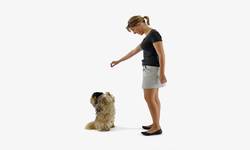One of the most revealing studies in behavioral psychology was carried out by Russian physiologist Ivan Pavlov (1849-1936) in a series of experiments today referred to as 'Pavlov's Dogs'. His research would become renowned for demonstrating the way in classical conditioning (also referred to as Pavlovian conditioning) could be used to cultivate a particular association between the occurrence of one event in the anticipation of another.
Conditioning
Pavlov's Dog Experiments
Pavlov came across classical conditioning unintentionally during his research into animals' gastric systems. Whilst measuring the salivation rates of dogs, he found that they would produce saliva when they heard or smelt food in anticipation of feeding. This is a normal reflex response which we would expect to happen as saliva plays a role in the digestion of food.
Did You Know?
Psychologist Edwin Twitmyer at the University of Pennsylvania in the U.S. discovered classical conditioning at approximately the same time as Pavlov was conducting his research (Coon, 1982).1 However, the two were unaware of each other's research in this case of simultaneous discovery, and Pavlov received credit for the findings.
However, the dogs also began to salivate when events occurred which would otherwise be unrelated to feeding. By playing sounds to the dogs prior to feeding them, Pavlov showed that they could be conditioned to unconsciously associate neutral, unrelated events with being fed2.
Experiment Procedure
Pavlov's dogs were each placed in an isolated environment and restrained in a harness, with a food bowl in front of them and a device was used to measure the rate at which their saliva glands made secretions. These measurements would then be recorded onto a revolving drum so that Pavlov could monitor salivation rates throughout the experiments.
He found that the dogs would begin to salivate when a door was opened for the researcher to feed them.
This response demonstrated the basic principle of classical conditioning. A neutral event, such as opening a door (a neutral stimulus, NS) could be associated with another event that followed - in this case, being fed (known as the unconditioned stimulus, UCS). This association could be created through repeating the neutral stimulus along with the unconditioned stimulus, which would become a conditioned stimulus, leading to a conditioned response: salivation.
Pavlov continued his research and tested a variety of other neutral stimuli which would otherwise be unlinked to the receipt of food. These included precise tones produced by a buzzer, the ticking of a metronome and electric shocks.
The dogs would demonstrate a similar association between these events and the food that followed.
NEUTRAL STIMULUS (NS, eg. tone) > UNCONDITIONED STIMULUS (UCS, eg. receiving food)
when repeated leads to:
CONDITIONED STIMULUS (CS, eg. tone) > CONDITIONED RESPONSE (CR, eg. salivation)
The implications for Pavlov's findings are significant as they can be applied to many animals, including humans.
For example, when you first saw someone holding a balloon and a pin close to it, you may have watched in anticipation as they burst the balloon. After this had happened multiple times, you would associate holding the pin to the balloon with the 'bang' that followed. Like Pavlov's dogs, classical conditioning was leading you to associate a neutral stimulus (the pin approaching a balloon) with bursting of the balloon, leading to a conditioned response (flinching, wincing or plugging one's ears) to this now conditioned stimulus.
Similarly, Craik and Lockhart's Levels of Processing (1972) theory on memory suggests that the deep processing (e.g. repeated rehearsal) of a piece of information can lead to an increased likelihood that it will enter a person's long-term memory and the response that can be recalled at a later date3.
Let us look now at some of the nuances of Pavlov's findings in relation to classical conditioning.
'Unconditioning' through experimental extinction
Once an animal has been inadvertently conditioned to produce a response to a stimulus, can this association ever be broken?
Pavlov presented the dogs with a tone which they would come to associate with food. He then played the tone but did not follow that by rewarding the dogs with food.
After he made the sound without food numerous times, the dogs' produced less saliva as the conditioning underwent experimental extinction - a case of 'unlearning' the association.
Recovery
When experimental extinction occurs, is the association permanently broken?
Pavlov's research would suggest that it remains but is inactive after extinction, and can be re-activated by reinstating, for example, the food reward, as it was given during the original conditioning. This phenomenon is known as spontaneous recovery.
Forward Conditioning vs Backward Conditioning
During conditioning, it is important that the neutral stimulus (NS) is presented before the unconditioned stimulus (UCS) in order for learning to take place. This forward conditioning is more likely to lead to a conditioned response than when the neutral stimulus is presented after the conditioned stimulus has been provided (backward conditioning).
In the case of Pavlov's dogs, the tone must be played to the subject prior to the food being provided. Making a sound after the dogs have been fed may not lead to a conditioned association being made between the events.
Carr and Freeman (1919) attempted both forward and backward conditioning in rats, between a buzzer sound and closed doors in a maze. They found backward conditioning to be ineffective when compared to forward conditioning.4
Delay Conditioning vs Trace Conditioning
We may use forward conditioning in one of two forms:
-
Delay Conditioning - when the unconditioned stimulus is provided prior to and during the unconditioned stimulus - there is a period of overlap where the neutral and unconditioned stimulus are given simultaneously, e.g. a buzzer sound begins, and after 10 seconds, food is given whilst the buzzer continues.
-
Trace Conditioning - when there is a delay after the unconditioned stimulus has been provided before the unconditioned stimulus is presented to the subject, e.g. buzzer sounds for 10 seconds, stops and after 10 seconds of silence (the trace interval), food is presented.
Discussing delay conditioning, Pavlov (1927) asserted that the longer the delay between the stimuli, the more delayed the response would be5.
Temporal Conditioning
So far, we have looked at conditioning in which a neutral stimulus is key to eliciting a desired response. However, if an unconditioned stimulus is provided at regular intervals, even without a preceding neutral stimulus, animals' sense of timing will enable conditioning to take place, and a response may occur in time with the intervals.
For example, in a study in which rats were fed at either random or regular intervals, Kirkpatrick and Church (2003) found that the subjects underwent temporal conditioning in the anticipation of food when they were fed at set intervals.6
Generalisation
Pavlov noticed that once neutral stimulus had been associated with an unconditioned stimulus, the conditioned stimulus could vary and the dogs would still generate a similar response. For example, once specific tone of buzzer sound was associated with food, differing toned buzzer sounds would solicit a conditioned response.
Nonetheless, the closer the stimulus was to the original stimulus used in conditioning, the clearer the response would be. This correlation between stimulus accuracy and response is referred to as a generalisation gradient, and has been demonstrated in studies such as Meulders et al (2013).7
Modern Classical Conditioning
Pavlov's dog experiments are still discussed today and have influenced many later ideas in psychology. The U.S. psychologist John B. Watson was impressed by Pavlov's findings and reproduced classical conditioning in the Little Albert Experiment (Watson, 1920), in which a subject was unethically conditioned to associate furry stimuli such as rabbits with a loud noise, and subsequently developed a fear of rats.8
Classical conditioning forms the basis of behaviorist approach which he articulated in Psychology as the Behaviorist Views It (Watson, 1913).9
The numerous studies following the experiments, which have demonstrated classical conditioning using a variety of methods, also show the replicability of Pavlov's research, helping it to be recognised as an important unconscious influence of human behavior. This has helped the theory to be recognised and applied in many real life situations, from training dogs to creating associations in today's product advertisements.



























